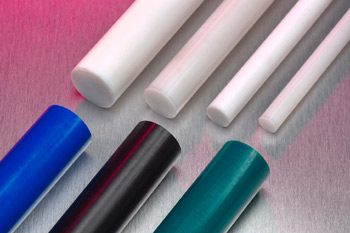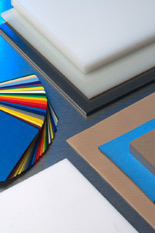PTFE Properties & PTFE Material
With more than 20 years experience in PTFE properties our technical team are on hand to assist you in choosing your optimal choice of parts & PTFE material to work best within the critical parameters of your project. Our advice can be as broad ranging as helping you consider elements such as chemical compatibility, temperature and mechanical strength. Our experts can provide you with reassuring examples through their experience and recent case studies. Our most popular PTFE material choices are outlined here with many more detailed below.
PTFE
PTFE – Polytetrafluoroethylene best known under the DuPont trade name of Teflon.
A high performance plastic with excellent chemical resistance. It is inert to practically all chemicals and has excellent non-stick properties. It is relatively soft which is ideal for sealing applications but not good for mechanical strength in threads. Can also be available with a range of fillers in particular glass and carbon which will increase it’s strength. Working temperature upto 250 degrees C
PEEK
PEEK – Polyetheretherketone
A high performance plastic. Inert to most chemicals except concentrated oxidising acids such as Sulphuric and Nitric acid and the solvents THF, DMSO and Methylene Chloride may cause some swelling. Much harder than PTFE so suitable for threads.
POM
POM – Polyoxymethylene best known as Acetal or the DuPont trade name Delrin
An excellent machining plastic. Not very chemically resistant but used extensively in non-wetted applications. Normally available in white and black and both have good finishes.
PCTFE
PCTFE – Polychlorotrifluoroethylene best known under the 3M trade name Kel-f
An expensive fluoropolymer with chemical resistance similar to PTFE. Much harder than PTFE. Also can be used upto working temperatures of 200 degrees C
PVDF
PVDF – Polyvinylidenefluoride best known under the 3M trade name Kynar
Although better known for its moulding properties, PVDF can also be successfully machined. It is not as chemically resistant as PTFE as it can be attacked by some Alkaliis and some halogenated hydrocarbons. It also has an upper working temperature of 150 degrees C
Polyamide
PA – Polyamide a family of polymers that is better known as Nylon
A very common plastic and is used for its high strength and abrasion resistance. It’s chemical resistance is poor and it also has a tendency to swell in water.
Polypropylene
PP- PolypropyleneAnother very common plastic with quite reasonable chemical resistance but a relatively low upper working temperature of 120 degrees
PMMA – Polymethylmethacrylate better known under the ICI trade name Perspex or the generic name ‘Acrylic’ is a clear plastic used in applications where visibility is important. It has a poor chemical resistance and can be prone to scratching.
Other high performance plastic available includes
Polycarbonate, Polyethylene (UHMWPE, HDPE, LDPE), Polyethyleneterephthalate (PET), PETFE


See our services pages for more information about a PTFE seal and o rings or our products page.





